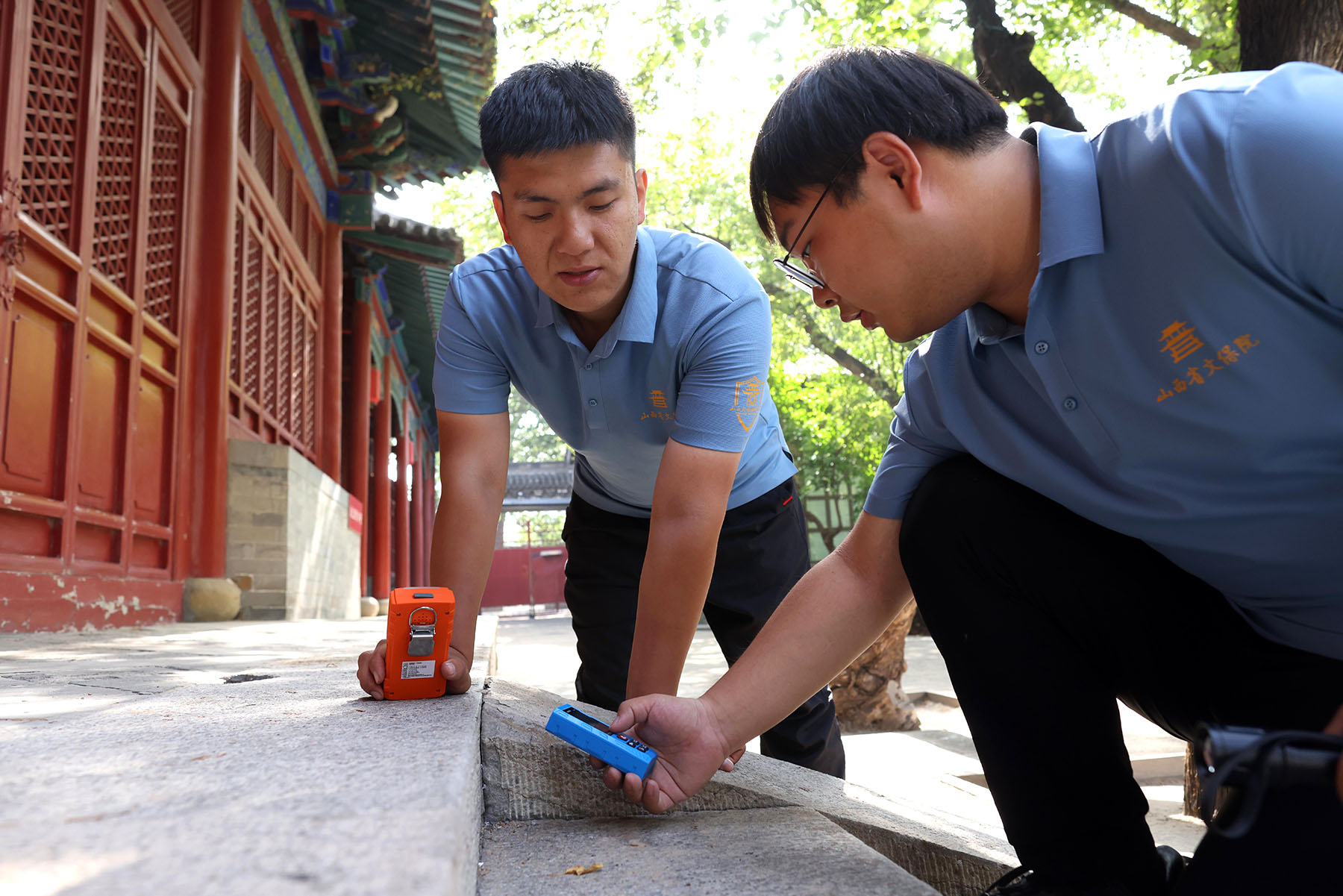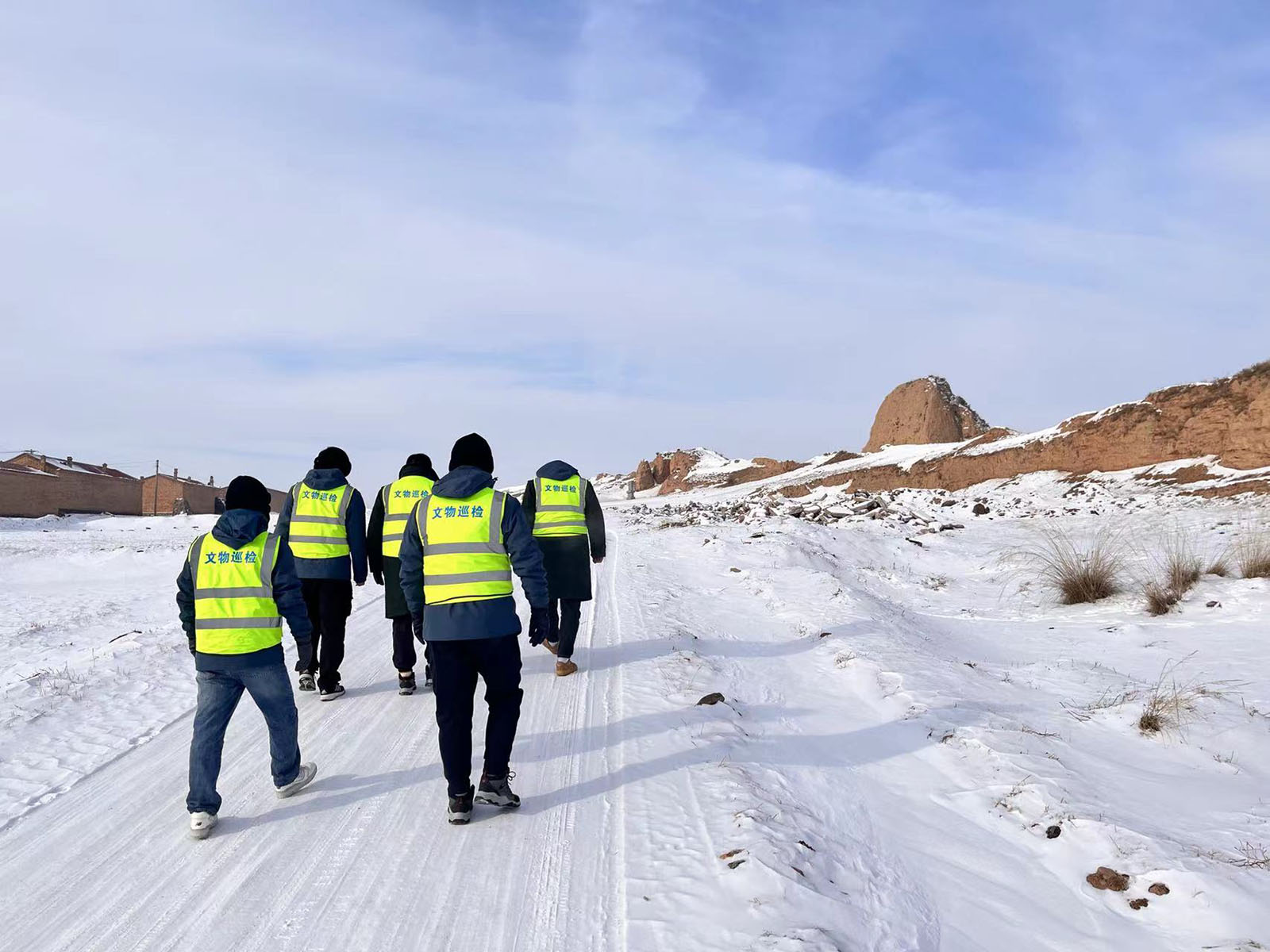Human grit and new tech prevent theft and help maintain culturally important structures and items, report Wang Qian and Zhu Xingxin in Taiyuan.

Safeguarding more than 50,000 immovable treasures — including 531 national-level sites and three UNESCO World Heritage entries — Shanxi province faces a Herculean task: preserving millennia of history against time, nature and human damage. Now, a groundbreaking blend of technology and grit is turning the tide.
While cultural relics' inspectors trek mountain trails in Xinzhou, Shanxi, the Shanxi Cultural Relics Safety Command Center, hundreds of kilometers away, monitors real-time data. Giant screens map more than 1,300 sites via 1,211 cameras and 595 sensors. This is described as "giving relics eyes and ears" by Yang Haijun, a retired expert from the Shanxi Cultural Heritage Protection Institute that develops the monitoring platform.
With more than 20 years' frontline relic preservation experience, Yang knows how technology is helping in the battle against time and neglect, due to lack of hands. For decades, understaffing has plagued Shanxi's relics' conservation efforts.
"Watching ancient structures decay felt like seeing elders tremble in the wind," Yang says.
READ MORE: Interlocking past with present
The solution now gleams across giant screens at the bristling command center. Using artificial intelligence, it scans for threats like illegal construction, fires or intrusions, while building-mounted sensors track environmental risks like humidity or smoke.
Operating since December 2024, the platform has flagged 115 anomalies — from wildfires to illegal digging — with 97 percent resolved swiftly via automated alerts to local authorities, according to Liu Yubo, a staff member of the platform.

One of the cases occurred in September 2024, when Liu received an alert: Surveillance equipment detected construction activity near the Jijiazhuang site in Datong, Shanxi.
"Upon receiving the alert, frontline protection staff promptly responded. They informed the construction company about the cultural heritage protection policies and required them to adjust the routes of their construction vehicles to avoid the protected area of the site. Ultimately, the issue was resolved," Liu says.
"Before, accidents went unnoticed. Now, AI detects risks early, while they can still be fixed," Yang says with a smile.
In a 24/7 operation, the platform also connects to a mobile app installed in the phones of local cultural heritage protection staff members, who can report any issues online, Liu says.
Yet, no algorithm can replace human determination in rugged terrain where roads no longer exist.
For patrol members like Wang Kai, missions often demand extraordinary perseverance. The 40-year-old insists that no sensor can ever replace human sight.
Last year, Wang's team faced their toughest challenge at Baifotang Temple — a Ming Dynasty (1368-1644) structure abandoned in Dingxiang county's mountainous Jicheng village after residents relocated.
Situated at an altitude of nearly 1,300 meters in a valley with significant elevation differences, it is challenging to reach the stone-carved structure designed to resemble the appearance of wooden architecture. During the rainy and snowy seasons, the route is almost inaccessible.

For Wang, the trek was a battle: a 2-hour slog through rugged terrain under scorching sun, leaving team members suffering from heatstroke. What they found was heartbreaking: crumbling walls inviting thieves, rotting beams at risk of fire, and wilderness reclaiming the courtyard.
"The entire stone hall, along with its associated artifacts, including 104 stone carvings of various sizes, were exposed to the elements, posing a security risk," Wang recalls, adding for fire prevention, the fire-fighting equipment was inadequate, and the surrounding area was overgrown with weeds, with grass growing on the roof, creating a fire hazard.
"Standing there, we heard the temple crying for help," Wang says.
There are now smoke detectors and intrusion and anti-theft alarms installed at the entrance gate of the temple, as well as temperature and humidity sensing indoors. An environmental monitoring system was set up to cover the entire premises.
"If there is any unusual activity indoors, our security platform will provide feedback and alerts. This serves as a technical support feature on the security platform," Wang says, adding that technology helps turn "lack of protection" into "round-the-clock guardianship".
Over the past two years, there have been eight "health reports "about the temple to provide guidance on maintenance and preservation for the local authorities.
Efforts from Wang's team paid off as the temple's restoration plan is gradually being implemented. The restoration of the main structure has already been approved and is now in the subsequent implementation phase.
Across Shanxi, there are 15 such specialized units (equipped with drones, thermal scanners and GPS), according to Yang. In the past two years, a total of eight rounds of comprehensive safety inspections were conducted at national and provincial protection units.

Between 2023 and 2024, the number of identified issues and hazards decreased from 1,256 per round to 274 per round, a reduction of 982 instances, representing a 78 percent drop. The rectification rate for issues and hazards increased from 32 percent to 71 percent, according to official statistics.
Where patrollers cannot climb, drones ascend. Nine fixed and mobile drone units now cover the province's most inaccessible sites — like the Great Wall section at Heyang Fortress in Shanyin county, Shuozhou.
In August 2024, a drone scanning the wall detected illegal excavation via thermal imaging. Within two hours, county teams were dispatched. Using 4K footage and GPS coordinates, they filled the site, while drones monitored repairs — a process repeated until compliance was confirmed weeks later.
According to local inspection teams, thermal sensors flagged illegal excavation at the fort's northern section during a 30-meter-altitude drone scan. Rapid response measures were conducted, including GPS-precise coordinates sent to the command center within minutes, county teams mobilized in under 2 hours and real-time drone monitoring guided backfilling of dug-out sections.
Simultaneously, inspectors educated nearby villagers using aerial footage showing wall vulnerabilities — merging enforcement with community engagement. In the next month's follow-up inspection, drone scans confirmed full restoration.
But Liu admits that there are limits and blind spots in technology, because there are sometimes false alarms, and when sensors cannot tell the real situation, it is humans playing a role.
ALSO READ: Mapping out history of Hexi Corridor for future
"Once there was a fire alarm at a temple in Linfen, but when we sent an inspection team there, it was only smoke from cooking next door," Liu says.
"Protecting relics isn't a sprint — it's a marathon across generations," says Yang. From scaling on feet to remote monitoring, Shanxi's model proves that when technology empowers tradition, even the most fragile heritage can endure.
At this year's Cultural and Natural Heritage Day opening ceremony on June 14 in Changsha, Hunan province, the National Cultural Heritage Administration named Shanxi's smart on-site patrol model one of the Top 10 High-Quality Development Cases in the country's cultural heritage sector in 2024.
Contact the writers at wangqian@chinadaily.com.cn


